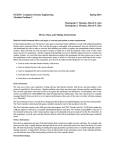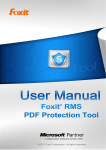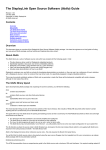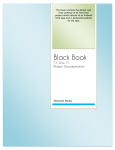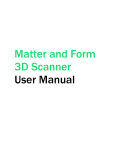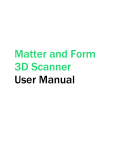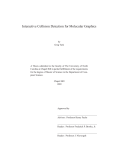Download Checkpoint LAB USB-RS232 Specifications
Transcript
ECE391: Computer Systems Engineering Machine Problem 2 Fall 2014 Checkpoint: Wednesday, October 1 Midterm 1: Monday, October 6 Due: Monday, October 13 Device, Data, and Timing Abstractions Read the whole document before you begin, or you may miss points on some requirements. In this machine problem, you will extend a video game consisting of about 5,000 lines of code with additional graphical features and a serial port device. The code for the game is reasonably well-documented, and you will need to read and understand the code in order to succeed, thus building your ability to explore and comprehend existing software systems. Most code that you will encounter is neither as small nor as well documented—take a look at some of the Linux sources for comparison—but this assignment should help you start to build the skills necessary to extend more realistic systems. As your effort must span the kernel/user boundary, this assignment will also expose you to some of the mechanisms used to manage these interactions, many of which we will study in more detail later in the course. Before discussing the tasks for the assignment, let’s discuss the skills and knowledge that we want you to gain: • Learn to write code that interacts directly with devices. • Learn to abstract devices with system software. • Learn to manipulate bits and to transform data from one format into another. • Learn the basic structure of an event loop. • Learn how to use the pthread API. Device protocols: We want you to have some experience writing software that interacts directly with devices and must adhere to the protocols specified by those devices. Similar problems arise when one must meet software interface specifications, but you need experience with both in order to recognize the similarities and differences. Unfortunately, most of the devices accessible from within QEMU have fully developed drivers within Linux. The video card, however, is usually managed directly from user-level so as to improve performance, thus most of the code is in other software packages (e.g., XFree86). We were fortunate to have a second device designed by Kevin Bassett and Mark Murphy, two previous staff members. The Tux Controller is that funny little game controller attached to each of the machines in the lab. The Tux Controller connects to the USB port of the lab machine. An FTDI “Virtual Com Port” (VCP) driver makes the USB port appear to software as a standard (old fashioned) RS232 serial port. We can then set up QEMU so that one of the emulated serial ports on the virtual machine maps to the emulated serial port connected to the Tux Controller. In this assignment, you will write code that interacts directly with both the (emulated) video card and the game controller board. Device abstraction: Most devices implement only part of the functionality that a typical user might associate with them. For example, disk drives provide only a simple interface through which bits can be stored and retrieved in fixed-size blocks of several kB. All other functionality, including everything from logical partitions and directories to variable-length files and filesharing semantics, is supported by software, most of which resides in the operating system. In this machine problem, you will abstract some of the functionality provided by the Tux controller board. 2 Format interchange: This machine problem gives you several opportunities for working with data layout in memory and for transforming data from one form to another. Most of these tasks relate to graphics, and involve taking bit vectors or pixel data laid out in a form convenient to C programmers and changing it into a form easily used by the Video Graphics Array (VGA) operating in mode X. Although the details of the VGA mode X layout are not particularly relevant today, they do represent the end product of good engineers working to push the limits on video technology. If you work with cuttingedge systems, you are likely to encounter situations in which data formats have been contorted for performance or to meet standards, and you are likely to have to develop systems to transform from one format to another. Threading: Since the advent of faster processors, it became possible to exploit code parallelism by creating multiple threads. Multiple threads of execution also allow logical separate tasks to be executed using synchronous operations. If one thread blocks waiting for an operation to complete, other threads are still free to work. Note that threads are different from processes. A thread is the smallest unit of processing that can be scheduled by an operating system. Multiple threads can exist within the same process and share resources such as memory. Different processes cannot share these resources. On a single processor, multithreading generally occurs by having the processor switch between different threads, which is known as context switching. Since context switching happens frequently, the user perceives the threads as running concurrently. In this machine problem, we illustrate the basic concepts by using a separate thread to clear away status messages after a fixed time has passed. You will need to synchronize your code in the main thread with this helper thread using a Posix mutex. You may want to read the class notes on Posix threads to help you understand these interactions. Later classes will assume knowledge of this material. Software examples and test strategies: In addition to these five learning objectives for the assignment, this machine problem provides you with examples of software structure as well as testing strategies for software components. When you design software interfaces, you should do so in a way that allows you to test components separately in this manner and thus to deal with bugs as soon as possible and in as small a body of code as possible. Individual function tests and walking through each function in a debugger are also worthwhile, but hard to justify in an academic setting. The modex.c file is compiled by the Makefile to create a separate executable that returns your system to text mode. We also made use of a technique known as a memory fence to check some of the more error-prone activities in the file; read the code to understand what a memory fence is and what it does for you. The Pieces Provided You are given a working but not fully-functional copy of the source tree for an adventure game along with a skeletal kernel module for the Tux controller. The Tux controller boards are attached to each machine in the lab. The table below explains the contents of the source files. 3 adventure.c assert.c input.c modex.c photo.c text.c world.c Game logic, including the main event loop, helper thread, timing logic, display control logic (motion and scrolling), and a simple command interpreter (command execution code is in world.c). Support for assertions and cleanups as design and debugging aids. Input control. Provides for initialization and shutdown of the input controller. The version provided to you supports keyboard control. You must write the support for the Tux controller. This file is not compiled with the rest of the game and should be used only to test your inputs separately from the game. Can be compiled stand-alone to test the input device. Functions to support use of VGA mode X. Includes things like switching from text mode to mode X and back, and clearing the screens. Provides a logical view window abstraction that is drawn in normal memory and copied into video memory using a double-buffering strategy. When the logical view is shifted, data still on the screen are retained, thus only those portions of the logical view that were not previously visible must be drawn. Finally, supports mapping from pixelized graphics in formats convenient to C into drawing a screen at a certain logical position. Relies on photo.c to provide vertical and horizontal lines from the photo images. Is also compiled stand-alone to create the tr text mode restoration program. Support for reading photo and object image data and mapping them into VGA colors. Also draws vertical and horizontal lines into graphics buffers for use with scrolling. Text font data and conversion from ASCII strings to pixelized graphic images of text (you must write the latter). Populates game world by setting up virtual rooms, placing objects, and executing commands issued by the player. We have also included two stripped binaries to illustrate your end goal. The adventure-demo program is a fully working version of the game that allows both keyboard and Tux controller input. The input-demo program is a stand-alone compilation of input.c, again allowing both forms of input. Finally, the mp2photo.c program can be used to transform 24-bit BMP files into photos for the game, and the mp2object.c program can be used for object images. Neither tool is needed for your assignment. The tr Program The make file provided to you builds both the game and a text-mode-restoration program called tr. The latter program is provided to help you with debugging. One difficulty involved with debugging code that makes use of the video hardware is that the display may be left in an unusable (i.e., non-text-mode) state when the program crashes, hangs, or hits a breakpoint. In order to force the display back into text mode for debugging purposes (or, if you are not running the program in a debugger, to regain control of your shell), you can run the tr program. Unless you are fairly confident in your ability to type without visual feedback, we recommend that you keep a second virtual console (CTRL-ALT-F1 through F6) logged in with the command to execute the text restoration program pre-typed, allowing you to simply switch into that console and press Enter. Using this program is substantially easier than rebooting your machine to put it back into text mode. You should also look at the cleanup handlers provided by the assert module (assert.h and assert.c). These cleanup handlers provide support for fatal exceptions, putting the machine back into a usable state when your program crashes. However, there may be instances and problems not covered by the handlers, and GDB can stop the program before the handlers are invoked, leaving the machine in an unusable state until you restore text mode with tr. Mode X and Graphic Images Mode X is a 256-color graphics mode with 320x200 resolution. It was not supported by the standard graphics routines that came with the original VGAs, but was supported by the VGA hardware itself, and was quickly adopted as the standard for video games at the time because of certain technical advantages over the documented 256-color mode (mode 13h, where the ‘h’ stands for hexadecimal). In particular, mode X supports multiple video pages, allowing a program to switch the display between two screens, drawing only to the screen not currently displayed, and thereby avoiding the annoying flicker effects associated with showing a partially-drawn image. This technique is called double-buffering. Each pixel in mode X is represented by a one-byte color value. Although only 256 colors are available in mode X, the actual color space is 18-bit, with 6-bit depth for red, green, and blue saturation. A level of indirection is used to map 4 one-byte pixel color values into this space. The table used in this mapping is called a palette, as it is analogous to a painter’s palette, which in theory holds an infinite range of colors, but can only hold a few at any one time. Palettes are often used to reduce the amount of memory necessary to describe an image, and are thus useful on embedded devices even today. For your final projects, some of you may want to play with graphic techniques such as palette color selection to best represent a more detailed image and dithering to map a more detailed image into a given palette. The mapping between screen pixels and video memory in mode X is a little contorted, but is not as bad as some of the older modes. The screen is first separated into blocks four pixels wide and one pixel high. Each block corresponds to a single memory address from the processor’s point of view. You may at this point wonder how four bytes of data get crammed into a single memory address (one byte in a byte-addressable memory). The answer, of course, is that they don’t. For performance reasons, the VGA memory was 32-bit, and the interface between the processor and the VGA is used to determine how the processor’s 8-bit reads and writes are mapped into the VGA’s 32-bit words. For example, when the processor writes to a memory address, four bits of a specific VGA register are used to enable (1 bits) or disable (0 bits) writes to 8-bit groups of the corresponding word in VGA memory. When drawing rectangles of one color, this mask reduces the work for the processor by a factor of four. When drawing images, however, it poses a problem in that adjacent pixels must be written using different mask register settings. As changing a VGA register value is relatively slow, the right way to use mode X is to split the image data into four groups of interleaved pixels, set the mask for each group, and write each group as a whole using the x86 string instructions (you won’t need to write any of these, although you may want to look at how it is done in the existing code or in the x86 manual). address 0xA1284 (0xA1234 + 80) address 0xA1234 address 0xA1236 address 0xA1237 0 1 2 3 0 1 2 3 0 1 2 3 0 1 2 3 0 1 2 3 address 0xA12D4 (0xA1234 + 160) address 0xA1235 0 1 2 3 ... ... ... (all at 0xA1236) plane 3 plane 2 plane 1 plane 0 Mode X video memory is memory-mapped and runs from (physical) memory address 0xA0000 to 0xAFFFF, for a total of 216 addresses and 256 kB of addressable memory (counting all four planes). The addresses used in your program are virtual rather than physical addresses, a concept to be discussed later in the course; don’t be surprised if they are not the same as the physical addresses, though. A full screen occupies 320 × 200/4 = 16, 000 addresses, so four fit into the full memory, with a little extra room. The VGA can be directed to start the display from any address in its memory; addresses wrap around if necessary. In the figure shown above, for example, the screen starts at address 0xA1234. Due to the timing behavior of emulated interactions with video memory, the code provided to you does not use a traditional double-buffering model in which the off-screen image is drawn directly within video memory. As with double-buffering, we do maintain two regions within the video memory for screen images. However, we use regular memory to maintain an image of the screen and to update that image in place. When a new image is ready for display, we copy it into one of two regions of the video memory (the one not being displayed) and then change the VGA registers to display the new image. Copying an entire screen into video memory using one x86 string instruction seems to take about as long as writing a small number of bytes to video memory under QEMU, thus our image display is actually faster than trying to draw a vertical line in video memory, which requires one MOV instruction per vertical pixel. Only the modex.c file relies on mode X. The rest of the code should use a graphics format more convenient to C. In particular, an image that is X pixels wide and Y pixels high should be placed in an array of dimensions [Y ][X]. The type of the array depends on the color depth of the image, and in our case is an unsigned char to store the 8-bit color index for a pixel. When you write code to generate graphic images from text, as described in a later section, you should use the same format. Graphical Mapping in the Game The game shows a two-dimensional photo for each virtual room in the simulated world, and the screen at any time shows a region of the current photo. The photo is fully resident in memory, but could in theory be constructed 5 dynamically as necessary to fill the screen. This facet is useful for games in which drawing the entire virtual world at once requires too much memory. build buffer mapped into build buffer using photo coordinates for mode X planes room photo pixels (0,0) (show_x,show_y) logical view window size of scrolling portion of video screen plane 3 of logical view plane 2 of logical view plane 1 of logical view plane 0 of planes shift in logical view the build buffer as the logical view moves within the room photo We use a build buffer to keep the pixel data relevant to the screen organized in a form convenient for moving into video memory in mode X. However, in order to avoid having to move the data around a lot in the build buffer (or redraw the whole screen each time we move the logical view window by one pixel), we break the room photo into 4x1 pixel chunks using the mode X mapping illustrated in the previous section. The address of the logical view window in the room photo is used to decide where to place the image planes within the build buffer, and moves around within the build buffer as the logical window moves in the room photo, as shown in the figure below. 0 1 2 3 this address is in the window for planes 1, 2, and 3 this address is in the window for plane 0 logical view window 0 1 2 3 The mapping that we have described has a subtle detail: the address range used for the different planes within the logical view window may not be the same. Consider the case shown above, in which show x & 3 == 1. As we move the logical view window around in the room photo, we need to keep each address block at a fixed plane in the build buffer (again to avoid having to copy data around). If we were to keep the planes in the order 0 to 3 and not put any extra space between them, the image of plane 0 would in this case overlap with the image of plane 1 in the build buffer. By reversing the order, we can avoid this problem (alternatively, we could have used a one-byte buffer zone between consecutive planes). The next problem is mapping the build buffer into the video memory. We use two buffers in video memory and map into the non-displayed buffer, then change the VGA register to show the new screen. You can read about this doublebuffering technique in the code and see how it works. The complexity with regard to the plane mapping is that we must map the build buffer planes, which are defined in terms of the room photo coordinates, into the video planes, which are defined in terms of the screen coordinates. The picture below illustrates this problem. In general, a cyclic shift of the planes suffices for the mapping. 0 1 2 3 0 1 2 3 video screen memory logical view window 0 1 2 3 build buffer layout 0 1 2 3 build buffer video memory 0 0 1 1 2 2 3 3 (a cyclic shift of planes) 6 The next question is the size of the build buffer. If we can limit the size of the room photo, we can allocate a build buffer large enough to hold any logical view window. If the window starts at pixel (0,0) in the room photo, plane 3 is placed at the beginning of the build buffer. If the window occupies the lower right corner of the room photo, plane 0 is placed at the end of the build buffer. Such calculations are not particularly hard. However, we do not want to restrict the size of the room photo, so we add a level of indirection and move the relative offset of the logical view window within the build buffer as the logical view shifts within the room photo. The room photo can thus be of almost arbitrary size, and is limited only by the size of the coordinate types (32-bit indices). (show_x,show_y) old logical view window old logical view window new logical view window (scr_x,scr_y) new logical view window build buffer before copy build buffer after copy new img3 + address of (scr_x,scr_y) old img3 + address of (show_x,show_y) copies a contiguous region of memory for simplicity The img3 and img3 off variables provide the additional level of indirection. At any point in time, adding the address calculated from the logical view window coordinates (show x,show y) to the img3 pointer produces a pointer to the start of plane 3 in the build buffer. However, the actual position of that plane in the build buffer may change over time. Whenever a new logical view window setting is requested, the code checks whether all four planes of the new window fall within the build buffer boundaries. If they do not, the window is repositioned within the build buffer in order to make it fit. To minimize copying, the planes of the new window are centered within the build buffer. The figure at the bottom of the previous page illustrates the process. Finally, we add a memory fence to the build buffer to ensure that we didn’t screw up the copying calculations. Read about it in the code. A Few Preliminaries Obtain a copy of the MP2 starting code. As with MP1, import an initial copy of the code from the class drive to your SVN repository. We suggest that you check out your working copy under your ECE work directory this time: when working with the Tux controller code, both of your virtual machines will need access to the files, and keeping them on the work directory server means that you don’t have to copy them around as often. Read the code and understand it. We will ask you questions about the code as part of the demo, and will also test your conceptual understanding of the techniques used in the code during examinations. Don’t be shy about asking questions on the web board, but do be careful so as not to give away MP answers. For example, it’s ok to ask and 7 answer questions about memory fences or other code given to you, but it’s not ok to give code or pseudo-code for writing a vertical line to the mode X build buffer (one of the tasks below). We expect you to follow good software engineering practices in your code. Variables should almost never be global. On the other hand, don’t go parameter-happy: file scope variables are fine. The code given to you has one global variable, which contains the font data for restoring text mode and for drawing text as graphic images while in graphics mode. Buffers passed to functions should either be fixed-size, or the available space should be passed and checked. Everything should be clearly thought out and well-commented. Functions should have function headers. Prototypes and variables should be organized, not scattered about the files. Indentation must be done correctly. The Checkpoint The order presented here is only a suggestion, but we do strongly recommend that you read the code first, that you tackle the parts one at a time rather than working on them all at once, that you commit working versions to your repository as you get each part working, and that you start with the easier parts. You must do all of these things for the first checkpoint. Other parts of the final MP are optional at the first checkpoint, and will not serve to make up points for missing required functionality. Write the vertical line drawing routine in modex.c. Everything but the function body is already in place for you (even the function header!), and you can look at the horizontal line drawing routine right next to it, so this part should be an easy place to start. The main difficulty is for you to understand both how mode X maps pixels and how the abstractions in modex.c work, so try to read the code and documentation to the point that you feel you understand these things, then try to write the function with the help of the examples. Find the VGA documentation for the status bar. Doing so was part of PS2, and you can work together and discuss how it should be done, but not trade code to do it. Add the status bar to the game. It should be big enough to allow you to write a line of text with an extra pixel above and below. How big is that? Read the code. Defined constants have been cleverly included to reduce the amount of work for you (see IMAGE versus SCROLL dimensions in the code), but you will have to shift a couple of bits of the existing code around here and there because of VGA constraints. Write a text to graphics image generation routine in text.c. Given a string, it should produce a buffer that holds a graphical image of the ASCII characters in the string. The height of the buffer is fixed. You may either (a) figure out how much text fits on the status bar and produce a buffer of fixed-size, or (b) return the resulting image width. In either case, the text must be centered on the bar, in case (a) by this routine, and in case (b) by the next routine. Don’t forget to put a prototype and explanation into text.h. Write a routine to put a graphic image, and in particular, the output of routine described in the previous paragraph, on to the status bar. Use your routine to fill the status bar with text. Synchronize with the helper thread, then check for a non-empty status message. If one exists, show it on the bar. Otherwise, put the room name and current typing on the bar. Arrange these things as you see fit to make them attractive. Be sure to look ahead at the rest of the assignment. You may want to get an early start. VGA Palette Manipulations The rest of the MP, which is also only due at the final due date, consists primarily of manipulating VGA palette colors and making use of the event loop to control timing. Find the VGA documentation for setting palette colors. As with the status bar, doing so was part of PS2. Write a function that sets a palette color. Put the function in modex.c. Notice the difference in color quality between the demo version of the adventure game and the distribution provided to you. The version provided to you maps each photograph into 6-bit color, using only 64 of the 256 colors available in mode X. The same 64 colors are used for objects and the status bar. 8 To improve the visual quality of the game, you must optimize the remaining 192 colors for the photo being displayed and adjust these colors whenever the player moves to a new room. Color optimization requires that you implement an algorithm based on octrees, which will be explained later. Final CP: Tux Controller Serial Port Device This portion of the MP is due on the final due date. A subsequent document will be released with the tux controller requirements. Your requirements in the game are: • Display the elapsed time (minutes.seconds) on the 7-segment displays. • Up/down/left/right on the tux controller have the same affect as the keyboard’s keys. • A/B/C on the tux controller should have the same affect as Ins/Home/PgUp. Final CP: Color Clustering using Octrees The Task: The graphics mode used in MP2 provides a 320 × 200 display in which each pixel color is specified using one byte. The 8-bit value for a given pixel is used as an index into a palette of 256 colors, each of which is selected from one of 218 possible colors. These palette colors, as you should know from the pre-lab, are stored in VGA memory by writing three bytes corresponding to the red, green, and blue components of a color. The two most significant bits in each byte are ignored, leaving six bits (0 to 63) for red (R), six bits for green (G), and six bits for blue (B). In contrast, many image formats provide 24-bit RGB color for each pixel. The .photo files in the distribution have been transformed into a smaller format in which each pixel is represented with a 16-bit value in which the five most significant bits form a red component, the middle six bits form a green component, and the five least significant bits form a blue component. Visually, you have bits as shown here: RRRRRGGGGGGBBBBB. The code that we distributed to you maps these 16-bit values into the first 64 VGA palette colors, which have been set up for you (in modex.c) to provide 6-bit RGB colors (two bits each). These colors are also used for objects in the game, and you must not change them. The other 192 colors are free for your use in selecting colors that best represent the content of an individual room photo. Your task, then, is to implement an algorithm that examines the 16-bit pixels for a single room photo, selects 192 colors that enhance the visual quality of the photo, transform the image data stored in the file into a C array containing appropriate bytes (one-byte VGA colors), and set the VGA palette registers to the colors that you have selected whenever that particular photo is displayed by the game. Octrees: The most common algorithms for mapping the multitude of colors that comprise a typical image into a smaller number for display on a computer screen make use of octrees, or degree eight trees. Each level of such a tree categorizes pixels based on one bit of red, one bit of green, and one bit of blue. The eight possible children for a node correspond to the eight possible values of these bits. An example using two colors (one level of a quadtree) is shown to the right. Here, pixels corresponding to colors with the most significant bit of both their red and blue components equal to 0 are added into the lower left quadrant of the tree. Those with blue MSB equal to 1 and red MSB equal to 0 are added to the upper left quadrant. And so forth. Each quadrant can then be subdivided into four parts based on the second MSB of red and the second MSB of blue. And the process can continue as long as we have bits of colors left. In the first level of an octree, we also make use of the green component’s MSB, resulting in eight octants. Each of these octants can then be subdivided into eight octants based on the second MSB, and so forth. With 5:6:5 RGB, we could in theory build a tree six levels deep, but our algorithm will make use of only four levels. An octree need not be built as a pointer-based data structure. In fact, we strongly recommend that you not try to follow such an approach. Since each level contains exactly eight children for each node, each level fits easily into an array. For example, the first level is an array of eight elements indexed by a concatenation of the RGB MSBs. The second 9 level is an array of 64 elements that you can index by any interleaving of the two MSBs of each color—we suggest RRGGBB, but just be sure to use the same interleaving of bits for all uses. Other levels are equally straightforward. The Algorithm: This section outlines the algorithm that you must use. The text here is simply a rewriting of Section 2.2 from http://www.leptonica.org/papers/colorquant.pdf, which is in turn mostly a practical overview of earlier work along with some useful implementation details. The paper does provide enough references for you to trace back to much of that earlier work (most of which you can find free online or by leveraging UIUC’s online library subscriptions). The paper also provides a number of more sophisticated algorithms, which you are welcome to attempt or extend. As usual, we strongly recommend that you first get this version working and save a copy to avoid unhappiness at handin time. The basic idea behind the algorithm is to set aside 64 colors for the 64 nodes of the second level of an octree, and then to use the remaining colors (in this case, 128 of them) to represent those nodes in the fourth level of an octree that contain the most pixels from the image. In other words, you choose the 128 colors that comprise as much of the image as possible and assign color values for them, then fill in the rest of the image with what’s left. The first step in the algorithm requires that you count the number of pixels in each node at level four of an octree. Define a structure for all relevant data for a level-four octree node, then create an array of that structure for your algorithm. Go through the pixels in the image file, map them into the appropriate octree node, and count them up. Once you’re done, you must sort the octree nodes based on the number of pixels appearing in each and select the most frequent 128 for specific palette colors. The C library qsort routine will help here, provided that you have recorded some sort of color identifier in your node structure for use after the sort completes. If you’re not already familiar with the C library implementation of quicksort, you may want to read the man page (man 3 qsort) to avoid implementing your own sorting routine. What 18-bit color should you use for the palette? The average of the 5:6:5 RGB values for those pixels that make use of the color. Note that you must calculate the averages for red, green, and blue separately. Calculating the average of the 16-bit pixels directly may be amusing, but will not earn many points. Rather than going through the pixels in the file again, of course, you should keep track of the necessary data during the first pass and calculate averages only for those 128 nodes for which you plan to assign palette colors. Eventually, you also need a way to map these 5:6:5 RGB color values into the 8-bit VGA colors that you assign, so be sure to keep track of the mapping implied by your octree node selection. Every pixel in the image must be assigned a color, of course. The next step in the algorithm is to assign the remaining 64 palette colors to the 64 level-two octree nodes. You may find that in some images, some of these nodes contain no pixels—you need not bother to optimize this case by reassigning the palette colors to level-four nodes. What 18-bit color should be used for the palette for the level-two octree nodes? As before, the average of the 5:6:5 RGB values for those pixels that make use of the color. Here there’s a twist, however: any pixels that have been assigned to one of the level-four octree nodes do not make use of the level-two palette color. So you must remove their contribution before calculating the average color for the level-two node. Your code should write the palette values that it selects for an image in the photo t structure along with the final image data. Once your code has finished selecting colors and palette values, it must go through the file data again and map 5:6:5 RGB values into VGA colors. Don’t forget that your colors are indexed from 0 to 191 in the arrays, but must occupy colors 64 to 255 in the VGA palette. The first 64 colors in the palette are used for objects and the status bar. You may want to review fseek (man 3 fseek) to help you go over the file data again. Finally, don’t forget to make use of the palette that you define (probably in prep room) via your set palette function. My implementation, including all structures, variables, and code, required a little over 150 lines. Handin Both the checkpoint and the final handin will require you to sit down with a TA in the lab to demonstrate your code and to answer a few questions. 10 Grading Note that the “correct” behavior of certain routines includes interfaces that allow one to prevent buffer overflows (i.e., the interfaces do not leave the size of a buffer as an unknown) and other such behavior. While the TAs will probably not have time to sift through all of your code in detail, they will read parts of it and look at your overall design. Also note that if you miss functionality points at the checkpoint, you will be able to regain half of those points by completing the functionality by the final due date.










